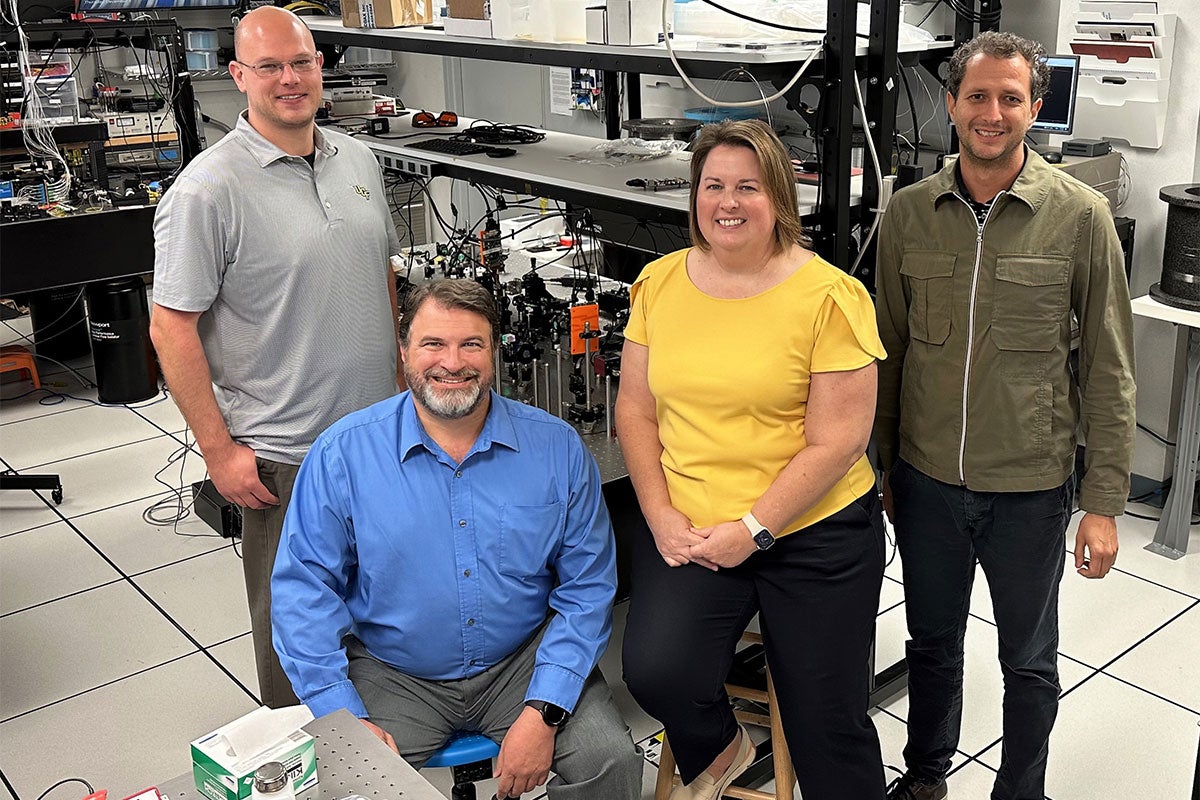An interdisciplinary team of faculty researchers from CREOL, The College of Optics and Photonics, and UCF’s physics department has won the opportunity to develop a system that uses photonics to more accurately visualize space debris — an increasing problem since the start of the space age.
The UCF team won the National Security Innovation Network (NSIN)-sponsored Air Force Research Laboratory (AFRL) Quantum-inspired Efficient Information Extraction for Electro-optic Systems Grand Challenge — earning $125,000 to fund their research. The competition continues over the next nine months with four development phases, through which up to $500,000 may be awarded to develop high-resolution space imaging solutions.
“We are excited to work with UCF for the next phase of this grand challenge,” said Sarah Krug, AFRL sensors directorate and laser radar optics research engineer, in an NSIN release. “We have confidence in their well-defined solution to our problem, and we look forward to seeing how their photonic lantern technology influences quantum-inspired high-resolution sensing.”
UCF’s project, the PQI2: Photonic Quantum Inspired Imager, is led by CREOL professors Stephen Eikenberry and Rodrigo Amezcua Correa. It is also supported by CREOL doctoral candidate and U.S. Space Force Major Matthew Cooper and Kerri Donaldson Hanna, assistant professor of physics and a member of UCF’s Planetary Sciences Group.
“We are honored that the AFRL chose to support our approach to this growing problem,” says Eikenberry. “We look forward to combining our proven photonic lanterns with new innovations in hardware to accurately identify and characterize space debris with unprecedented resolution.”
The AFRL issued a call for white papers from small companies, large defense contractors, and other universities to address the problem of human-made space debris detection and asteroid, comet, and interstellar object characterization. The challenge was to design and demonstrate a device that can sense beyond traditional imaging limitations, such as the Rayleigh diffraction limit, and recreate an image of the object sensed. AFRL will use the UCF team’s results when building future advanced systems.
“Our team’s advanced techniques and photonic lantern hardware expertise enables us to use new solutions which can approach the quantum resolution limit,” says Amezcua Correa. “In other words, our system will produce clear images using new technology we will create at UCF.”
Space debris presents a serious threat to future space research and commercialization for the United States and the world at large. It has been an increasing problem since the launch of the first human-made satellite, Sputnik, in 1957, marking the beginning of the space age.
“Unfortunately, it is common practice for space assets to be Intentionally destroyed once their operational life is finished,” says Eikenberry. “Additionally, advances in space technology and operations bring new risks of the nefarious destruction of spacecraft and satellites by adversaries which will contribute to more space debris.”
Current studies estimate 100 million pieces of space debris in orbit — many too small to track with current imaging technology. Debris as small as a marble traveling at an orbital velocity of 17,500 mph can cause mission-ending damage to spacecraft and satellites.
“A satellite colliding with space debris could potentially destroy capabilities to monitor hurricanes, distribute GPS navigation signals, or provide critical communication links to U.S. military personnel in hazardous areas across the globe,” says Cooper. “A collision with a manned spacecraft could be fatal.”
The potentially catastrophic effects of “space junk” are being voiced by NASA, the U.S. Space Force, the entire commercial space industry, and world leaders. Due to the potential damage from such small objects, the White House published a National Orbital Debris Implementation Plan emphasizing the need to limit the debris created during space operations, and pushing for improved capabilities in tracking, characterizing, and even removing or destroying the debris.
A crucial first step towards mitigating the threat is improved information on the nature of the debris including the size, shape, composition, rotation and time evolution of individual objects. However, current telescopes have not yet leveraged photonic components to produce the sub-diffraction-limit observations necessary to produce clear images. Current imagery is blurry, sometimes making it difficult to determine if a photo is of one object or a group of objects, or if it is human-made or naturally occurring.
“Natural occurring debris, like some cometary- and asteroidal-materials, may simply disintegrate upon impact with a spacecraft or satellite while others can pose a serious threat,” says Donaldson Hanna. “It is critical to accurately identify the type of space debris so appropriate action can be taken.”
As UCF continues to the next phase of the competition, the team’s research will encompass the effort to build, evaluate and document the final system. The phases will include fabrication, integration and laboratory testing of a functioning system. The final phase will be an on-sky demonstration.
“Our work in this area has benefited significantly from a UCF Jump Start Award for Photonic Atmospheric Sensing Technology (PHAST),” Eikenberry says. “We would not have been in a position to win the AFRL award without the advancements we made using Jump Start funding.”
The Jump Start Fund was made available in 2021 by UCF President Alexander N. Cartwright as part of his strategic investment program to help position the university as the world’s leading public metropolitan research university. The fund gives UCF a new avenue for enhancing academics and student success.




